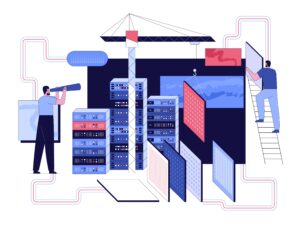Enterprise applications are designed to meet the unique needs of large-scale businesses. They may promote better teamwork, boost productivity, and simplify corporate procedures.
Creating enterprise applications may be complicated. The traditional method requires a long time, little teamwork, and difficulty finding qualified developers. These obstacles may delay development and produce less-than-ideal results.
This blog will explain enterprise application development, how it differs from traditional mobile app development, its main features, and how to create an enterprise application.
What is Enterprise Application Development?
Enterprise application development involves creating, developing, and implementing software applications designed specifically for major corporations or enterprises. These applications are usually complex and mission-critical and designed to meet the unique demands of an organization with multiple departments, procedures, and activities.
Difference Between Traditional & Enterprise App Development
Here are some differences between both approaches.
|
Traditional App Development |
Enterprise App Development |
|
Slow process |
Fast process |
|
Dependency between an application and its operating system makes scalability and migration a complex task |
No dependency between the application and the operating system. |
|
Slow process for solving app problems. |
App updates are performed faster. |
|
Slower transitions |
Swift and smooth transitions |
|
Costly |
Cost-effective. |
|
Less secure |
Secure and easy-to-use data storage. |
What are some drawbacks of Enterprise App Development?
Below are a few drawbacks of enterprise app development that you must know:
1. Legacy System
Many organizations still use legacy systems and outdated software applications that have been used for a long time.
However, because these systems were developed years ago, they often lack compatibility with modern technologies, making it challenging to integrate them with new enterprise applications.
Moreover, legacy computer systems may have limited functionality, poor performance, and security vulnerabilities, making them less suitable for modern business needs.
2. Poor Collaboration Between Business and IT
When creating effective applications for businesses, collaboration between the business and IT teams is crucial.
However, aligning business and IT strategies can sometimes become a challenge. Meeting the organization’s requirements can be difficult when there is a mismatch in strategies.
Business teams may have unrealistic expectations, while IT teams may find it challenging to develop solutions that align with business goals.
This mismatch can lead to delays, rework, and inefficient resource use, ultimately affecting the project’s success.
3. Developer Shortage
It’s no secret that there is a high demand for skilled software developers, but unfortunately, the supply doesn’t always meet the demand.
Many organizations struggle with recruiting and retaining qualified developers, which leads to a shortage of skilled professionals.
This scarcity can negatively affect enterprise app development, including project timeline delays and increased competition for proficient developers.
4. Lack Of Organizational Agility
Organizational agility is all about being able to respond promptly and efficiently to the changing needs of customers.
Companies that lack flexibility may encounter difficulties in adapting to evolving demands.
What Features an Enterprise App Development Platform Must Have?
Below are some of the important features that an enterprise application development platform must have:
1. Security
Enterprise app development platforms need to give utmost importance to security measures. By doing so, they can safeguard sensitive customer and company data.
This includes implementing secure authentication, data encryption, role-based access control, and ensuring compliance with industry standards and regulations.
2. Scalability
When developing enterprise applications, the ability to scale is of utmost importance.
Organizations must ensure their applications handle growing user loads, increasing data volumes, and higher transactional demands.
3. Integration
When choosing an app development platform, it’s important to prioritize those with strong data integration capabilities.
Additionally, it should easily integrate with your current business systems, including critical applications like CRM.
4. Cloud Access
As more businesses move towards cloud computing, it has become imperative for an enterprise application development platform to provide effortless integration with cloud services.
What are the stages of the Enterprise Software Development Process?
The enterprise software development process typically includes the following stages:
- Requirement Gathering
- Planning And Alignment
- UI/UX Design
- Software Development
- Testing & Deployment
- Support & Maintenance
Let’s have a detailed look at each stage.
1. Requirement Gathering
The first step in developing enterprise software is to gather and document comprehensive requirements.
This involves understanding the software’s business objectives, user requirements, and functional specifications.
The development team interacts with stakeholders, conducts interviews, and performs analysis to define the software’s scope, key features, and specifications.
2. Planning And Alignment
During this phase, a comprehensive project plan outlines the development approach, timelines, resource allocation, and milestones.
This plan ensures that the development team, stakeholders, and project objectives are all on the same page.
It involves creating communication channels, defining roles and responsibilities, and identifying potential risks and mitigation strategies.
3. UI/UX Design
During the UI/UX design stage, designers concentrate on developing an interface that is intuitive and easy to use for enterprise software.
Through creating wireframes, prototypes, and visual designs, designers align with user expectations and requirements.
Additionally, the UI/UX design considers accessibility, usability, and branding to deliver a visually appealing and seamless user experience.
4. Software Development
During this phase, the enterprise software is developed by skilled developers who write the necessary code and integrate different components and modules.
Additionally, they work on implementing the desired features and functionalities to ensure the final product meets the required standards.
5. Testing & Deployment
After the software development process is finished, a comprehensive round of testing is carried out to verify its functionality, performance, and dependability.
This testing process comprises a range of methods, including unit testing, integration testing, system testing, and user acceptance testing (UAT).
6. Support & Maintenance
Once the enterprise software is deployed, it needs regular maintenance and support. This involves fixing bugs and issues users report and releasing updates and patches. Technical support for end users is essential to ensure the software’s smooth operation.
Conclusion
In conclusion, enterprise application development is a complex process that requires careful planning, skilled development teams, and effective project management.
By utilizing the newest technologies and methodologies, businesses can create secure, scalable, and robust software solutions to meet their operations’ specific needs.
With ongoing maintenance and support, these applications can continue to deliver value and drive growth for the organization.
As technology evolves, it’s essential to stay up-to-date with emerging trends and best practices to ensure that your enterprise software remains competitive and effective.


